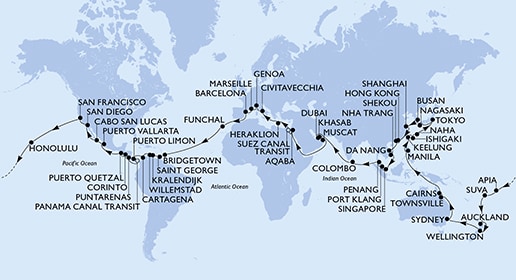
Port Funchal (Madeira)
Funchal, the capital of the Portuguese island of Madeira, is a picturesque city known for its stunning natural beauty, rich history, and vibrant culture. Nestled between lush mountains and the Atlantic Ocean, Funchal offers a perfect mix of urban charm and breathtaking landscapes. The city is famous for its colorful flower gardens, cobblestone streets, and historic architecture, including the iconic Sé Cathedral, which dates back to the 16th century. Visitors can stroll through the lively Mercado dos Lavradores (Farmer's Market), where local produce, Madeira wine, and traditional crafts are on display.
Funchal is also celebrated for its connection to nature and adventure. The Madeira Botanical Garden and Monte Palace Tropical Garden showcase the island's diverse flora, while a cable car ride to the hillside area of Monte reveals stunning views of the city and coastline. Thrill-seekers can experience the unique toboggan ride down Monte’s steep streets, a tradition dating back over a century. Whether exploring its historical landmarks, enjoying outdoor activities, or relaxing by the waterfront, Funchal offers a charming and unforgettable experience for visitors.
History
Funchal, the capital of Madeira, has a history deeply tied to Portugal's Age of Exploration. Established in 1421, shortly after Madeira's discovery in 1419 by João Gonçalves Zarco and Tristão Vaz Teixeira, the city was named after the wild fennel ("funcho") that grew abundantly in the region. During the 15th and 16th centuries, Funchal thrived as a key maritime hub, serving as a vital stopover for European ships traveling to Africa, the Americas, and Asia. The fertile volcanic soil of Madeira allowed sugarcane, known as "white gold," to flourish, driving Funchal's early wealth and making it one of Europe's first sugar trade centers. This economic boom attracted merchants, settlers, and pirates, prompting the construction of fortifications and grand religious structures such as the Sé Cathedral, completed in the late 15th century.
By the 17th century, Funchal shifted its focus to the production and global export of Madeira wine, which became a symbol of prestige in Europe and the Americas. The city gained further prominence in the 19th century as a health retreat and winter destination for European aristocracy, drawn to its mild climate and picturesque landscapes. Historical figures such as Empress Elisabeth of Austria and Winston Churchill visited Funchal, boosting its international reputation. Today, Funchal balances its rich heritage with modernity, boasting landmarks like the São Tiago Fortress and a vibrant harbor, while continuing to celebrate its legacy as a cultural and historical gem in the Atlantic.





 With air transport to the port
With air transport to the port



